|
Central
Park turns 150
By Jerry Shriver, USA TODAY
NEW YORK — Long before this metropolis became famous for skyscrapers and
neurotic citizens, civic leaders declared the need for an accessible
pastoral refuge — a "central park" — where the wealthy could promenade
in carriages, urchins could breathe clean air and the masses could just
relax under the elms.
That was in 1853. Eventually, when all of the political wrangling, land
grabbing, swamp dredging, bench building, tree planting and grass
seeding was done, the result was 843-acre Central Park, the nation's
first designed urban park. It celebrates its 150th birthday this year.
At a news conference April 29, New York Mayor Michael Bloomberg and
possibly first lady Laura Bush are scheduled to announce a seven-month
slate of special events to be highlighted by a birthday party July 19, a
film fest and several concerts (details at www.centralparknyc.org).
Bloomberg has called the celebrations "a tribute for the ages."
"We're going to have something for everyone to do, and we anticipate lots
of New Yorkers will celebrate the park that means so much to them," says
Regina Peruggi, president of the Central Park Conservancy.
Park experts from around the world also will join in. They're coming for a
conference in June that will explore how the private, non-profit
Conservancy has teamed with the city to run and finance the park and
implement $300 million in improvements since 1980.
That partnership is widely credited with rescuing the park from its
crime-ridden days of the mid-1900s and turning it into a showcase that
is visited by 25 million people a year.
"We concentrate on the fact that this is a very fragile place, and unless
it's kept up, it could easily deteriorate to where it was," Peruggi
says.
Today the masses are lured by the Metropolitan Museum of Art; Tavern on
the Green, the country's top-grossing restaurant; an outdoor theater
offering Shakespearean plays; a zoo; band shells blasting world-music
beats; and dozens of memorials honoring personalities as diverse as John
Lennon and Beethoven and a sled dog named Balto.
But they also still come to promenade, breathe deeply and soak up the
enduring landscape of lakes, meadows and forests laid out by architects
Frederick Law Olmsted and Calvert Vaux in their 1857 "Greensward Plan."
And to fall in love.
Says Michael Patrick King, executive producer of HBO's Sex and the City,
which has filmed several memorable scenes at the park: "Central Park is
a soft, natural oasis in the center of this concrete and steel city. It
represents the romantic heart that still beats inside our big-city
girls."
By the numbers:
Annual visitors: 25 million.
Total acres: 843, including 136 acres of woodlands, 150 acres of water and
250 acres of lawns.
Perimeter: 6 miles.
Miles of trails: 58 miles of pedestrian paths, 4.5 miles of bridle trails,
6.5 miles of Park Drive.
Benches: 6,000, which would stretch for 7 miles laid end-to-end.
Cost of "adopting" a bench: $7,500 to $25,000.
Cost of "adopting" a tree: $1,000 to $100,000.
Original construction cost: About $14 million from 1858-73 ($200 million
in today's dollars).
Restrooms: 17.
Hot dog/ice cream vendors: About 50.
Horse-drawn carriages: About 70 in the city, most in Central Park.
Playgrounds: 21.
Endowment of the Central Park Conservancy: $72 million.
Feeding times for penguins at the zoo: 10:30 a.m., 2:30 p.m.
----------------------------------
New York Times
May 15, 2003
Birth of Central Park Holds Parallels With Ground Zero
By GLENN COLLINS
What vast Manhattan architectural and public works project, the likes of
which New York City had never seen before, was begun in a time of
economic crisis and changed the city forever?
Hint: Stakeholders ranging from real-estate moguls to state and city
politicians exerted intense pressure. Republicans stepped in to bigfoot
the process. Initial, ho-hum plans were rejected. In the hard-fought
design competition that followed, a showdown led to the choice of the
Republicans' favorite. The winning and losing designs were placed on
display for all to see. Immediately, then, the winning design was
altered by powerful competing interests.
Another hint: Think way before ground zero.
The project was Central Park, and there are many eerie parallels between
that effort and the rebuilding of Lower Manhattan. "The creation of
Central Park, one of the greatest works of art in America, is an epic
story," said Morrison H. Heckscher, Lawrence A. Fleischman chairman of
the American Wing at the Metropolitan Museum of Art. "And the dynamic
hasn't changed all that much through the centuries."
Today the museum is celebrating the 150th anniversary of the park it has
inhabited since 1880 with the opening of "Central Park: A
Sesquicentennial Celebration." The exhibition, curated by Mr. Heckscher,
traces the design and building of the first great public park in
America. The show features the original presentation plans and drawings
by Calvert Vaux and Frederick Law Olmsted, who won an 1858 design
contest that was curiously echoed in the ground zero competition decided
last February.
On July 21, 1853, the State Legislature designated as "a public place" the
lands that were to become Central Park, accomplishing the unheard-of
removal of 17,000 potential building sites from the real-estate market.
"It's appropriate to celebrate the year of the Legislature's decision
rather than, say, the design competition in 1858," said Sara Cedar
Miller, the historian and photographer for the Central Park Conservancy,
which helped to organize the Met exhibition. "The vision to take so much
land for a city park was unprecedented in the history of this country."
The show's 60 original maps, drawings, watercolors, lithographs,
engravings, paintings and photographs include rare stereograph views of
the park from the museum's collections as well as those of the New York
City Municipal Archives, the New York City Department of Parks and
Recreation and the New-York Historical Society.
In the exhibit, the genesis of Central Park can be seen in an
8-foot-by-2.5-foot original engraving on heavy paper — decorated with a
blue and green wash — of the famous April 1811 commissioners' plan that
established the grid pattern for Manhattan. It delineated 12 north-south
avenues, 155 east-west streets and a planned public park called the
Parade, a 229-acre tract between 23rd Streets and 34th Streets.
As demonstrated by the subsequent 1836 Colton Map (a rare section of an
early engraver's test print is on view in the show), the Parade
succumbed to real-estate speculation before it could be built. The
ensuing clamor for a large public park ended in the election of Mayor
Ambrose C. Kingsland, who in 1851 proposed the creation of just such an
amenity.
"The rich wanted New York to be a major metropolis, and a park was de
rigueur, as in Paris and London," said Ms. Miller, author of "Central
Park, an American Masterpiece" (Harry N. Abrams, 2003, $45). "And
visionaries saw the park as an outdoor classroom in urban reform. They
thought immigrants would witness the fine clothes and the carriages and
would want to work hard to be part of the American dream."
In addition, as at ground zero, Mr. Heckscher said, "there certainly was
pressure to make a decision on the use of the land."
The city's parks at the time were largely decorous and enclosed, often
privately maintained, like Gramercy Park. And although City Hall Park
was open to the public, those hungry for nature had to cross the Hudson
or head to the dead at Green-Wood Cemetery in Brooklyn.
The State Legislature finally stepped in to check the corruption of
Tammany Hall, Ms. Miller said, and it voted to create a park from 59th
to 106th Streets, later expanded to 110th Street in 1863. Many of the
great 19th-century public parks of England and France had once been
royal hunting grounds given over to the people, "which makes the vote of
the Legislature to create a park even more unique," Ms. Miller said.
The Central Park tract was swampy, scrubby, rocky and not easily farmed.
Another of the treasures on view is the original 1855 drainage plan of
Egbert Ludovicus Viele, who was hired in 1854 to be the park's chief
engineer. He had come up with a design that, though lackluster, was at
first accepted by park commissioners in 1856. That workmanlike plan —
also presented in the exhibition — so appalled Vaux that he politicked
to throw the choice open to a competition.
Vaux had been a partner of Andrew Jackson Downing, the nation's foremost
landscape gardener, and he entered the competition with Viele's gifted
park construction superintendent, Olmsted. After toiling at his day job
in the park, Olmsted would travel to the town house of Vaux, helping to
design the park during the winter of 1857-58. Their hand-drawn original
11-foot-long-by-3-foot-wide presentation drawing is one of the stars of
the exhibition.
Also part of the exhibition are eight of the original 11 presentation
boards created by Olmsted and Vaux to hawk their plan. The boards
feature black-and-white "before" pictures of the existing parkland,
taken by the studio of the photographer Matthew Brady (some possibly by
Brady himself), as well as oil renderings of the park that would be,
some by Vaux. Alone among all the entries, the Olmsted and Vaux plan
(they called it Greensward) called for submerged road cuts, isolating
the park from crosstown traffic.
The park, Mr. Heckscher said, "was to be a place for passive
entertainment, and for the appreciation of nature — a public living room
for people of all classes, who were supposed to be on their best
behavior."
In all, there were 33 competing design proposals, compared with seven in
the final round at ground zero. In the end, the park battle narrowed
down to two plans, as in the recent drawdown between Daniel Libeskind
and Rafael Viñoly.
The exhibition presents two new discoveries: the runner-up design in the
competition by Samuel J. Gustin, as well as an exuberant original
ink-and-watercolor entry by John Rink. They have not been on public
display since the competition, and both were discovered by Ms. Miller.
Though the Gustin plan was originally the betting favorite (not unlike the
Viñoly plan after a key planning committee supported it at the 11th hour
in the February ground-zero smackdown with Mr. Libeskind), the
Republican-backed Greensward plan was victorious. The final 1858
commissioners' tally presaged the vote in 2003, when Republican Gov.
George E. Pataki threw his weight behind the Libeskind design.
Shortly after it was accepted, the Greensward plan was modified to
accommodate wealthy New Yorkers' demand for carriage drives and riding
trails, adding to the pedestrian paths originally envisioned. An attempt
to shrink the size of the park was beaten back by Mayor Fernando Wood,
"which was the best thing — and possibly the only good thing — he ever
did," Ms. Miller said, noting that Wood was an otherwise undistinguished
politician. In the end, admirers of Central Park inspired the movement
for state and national parks. And, even then, imitation was the
sincerest form of flattery. "Every city in the country," Ms. Miller
said, "wanted its own Central Park."
-------------------------------
Central Park's Golden Age
If a well-tended park can bring to mind the gaudy spring of Shakespeare's
sonnet, Central Park summons an epic of Homeric proportions. Taken all
at once, it is grand, sweeping, nearly overwhelming. Fortunately, it is
also digestible in small, delicious bites.
The park's 150th birthday is this year. It has taken that long to make the
park what it is today: a safe retreat where one's only worry is that
there's a more beautiful spot elsewhere that one may be missing. On one
recent morning at the north end of the park, a black-crowned Night-Heron
sat regally on a branch in the Harlem Meer, waiting to pluck lunch from
the fish-filled waters. Farther south, a waterfall glistened along a
wall of jagged black rock and puddled into the Pond, another serene pool
with coves and aquatic grasses, where a resident duck waddled ashore to
fetch one of her brood, briefly forcing passers-through to make way for
the duckling. In the Ramble and the North Woods, paths slice through
thickets of trees and shrubs with a density approaching a subtropical
forest's. Ferns sway on hilly terrain.
The 843 acres that make up the nation's best-known municipal park showcase
nature at its finest. But except for the naturally formed rock and some
of the creatures that inhabit or pass through the park, from 200 species
of birds to all kinds of dogs and people, the settings are made or
enhanced by man. Away from the obviously manicured greenery of the Great
Lawn (created from a drained reservoir in the 1930's), the Sheep Meadow
and the elm-lined Mall and Literary Walk, there are places shaped by
stealthy engineering. The park's ponds and lakes are carved out by
design, the fish they hold selected like tenants in an exclusive co-op.
A heron's perch will remain picture-perfect, because it has been
anchored at just the right spot. Trees, plants and flowers, seemingly
wild, are placed and tended with care. Hidden garden hoses create a
waterfall. This is art, the realization of Hudson Valley paintings and
imagined Edens. Taken together with its structures and monuments, from
the Metropolitan Museum of Art to the Bethesda Terrace, Central Park is
an ingenious effort to soothe and inspire 25 million visitors every
year.
Park officials date its beginning from July 21, 1853, when state
legislators voted to create a public space out of a rocky and swampy
plot of land on the edges of 19th-century New York City. Calvert Vaux
and Frederick Law Olmsted provided the blueprint several years later.
Their grand vision went beyond the European model, and not only in
landscaping. They foresaw that the rich and working classes alike could
find solace within its boundaries.
Over the years, the park came to symbolize the ills of the larger city,
hitting bottom in the mid-1970's, when it became a repository for
graffiti and garbage, thugs and drugs, its gardens and playgrounds in
ruins. Resurrection came with the establishment of the Central Park
Conservancy in 1980, which did something the city alone could not. The
conservancy marshaled the resources of the park's neighbors, raising and
spending $300 million to recreate and maintain the park as a model of
public-private partnership.
The anniversary will be marked on July 19 with fireworks and concerts. But
the real celebrating will be done by the city's lucky residents, as it
is every day, on skates and bikes, in sneakers and strollers, or
arm-in-arm, soaking up the joys of one of the greatest parks in the
world.
----------------------------
CNN:
Central Park: Grand experiment, urban respite
NEW YORK (AP) --Step off Fifth Avenue into Central Park and the
temperature can drop five degrees on a steamy summer day. Eyes
accustomed to grimy shades of city gray suddenly flood with every tint
of green. Breathe deeply: A heady combination of lilac and magnolia
overwhelms.
It's a place to scale rocks, to jog, to swim, to fly a kite, to simply
read a book. Life in New York would be "impossible" without the park,
declares Sarah Elliott, an avid bird watcher who takes visitors through
the Ramble, a 38-acre shaded woodland of secluded glades, ragged
outcroppings, cascades and a cave.
"There are so many things people worry about in this city," she says. "To
step into the park is a reprieve. You become part of Mother Nature's
plan."
Many visitors -- including native New Yorkers -- don't realize its scope:
58 miles of pedestrian paths and 150 acres of water. The varied
topography includes a few fiercely protected American elms; Harlem Hill,
a steep challenge tackled by thousands of bicyclists and runners each
year; craggy boulders worthy of any nature-starved rock climber; and
natural springs evoking the Catskills and Adirondacks.
There are small glades, quiet coves and a bridle trail around the
reservoir; hidden inlets and rustic rowboat landings along the
undulating shoreline of the 21-acre, butterfly-shaped lake at Bethesda
Terrace. Flat, wide-open stretches of lawn dwarf those of almost any
college campus.
People even fish on the Harlem Meer.
Yet, for all of its lush 843 acres, Central Park is a manmade oasis. The
vision of designers Frederick Law Olmsted and Calvert Vaux, it was born
150 years ago when the New York State Legislature set aside land for the
nation's first major public park.
Birthday celebrations
This year, theater, music, dance and sports mark a year of birthday
celebrations. Two museum exhibits commemorate its sesquicentennial. The
original plans and drawings of the "Greensward Plan" submitted by
Olmsted and Vaux are at the Metropolitan Museum of Art. "Central Park in
Blue," at the Museum of the City of New York, highlights newly
discovered blueprints by landscape architect Augustus Hepp. A new book,
"Central Park, an American Masterpiece," details the park's
extraordinary history.
There is much to celebrate. Central Park is almost restored to its
original splendor and drawing 25 million people annually, a leap from
the days when a fiscal crisis rendered it little more than an ugly wild
patch on the urban landscape.
The story began between 1853 and 1856, when city commissioners paid more
than $5 million for a rectangle of undeveloped land running from 59th
Street to 106th Street between Fifth and Eighth avenues. In 1858,
Olmsted and Vaux won a competition to design the space.
Ten million cartloads of soil were brought in to fill a landscape
consisting mostly of swamps and 450-million-year-old bedrock that was
moved or blasted with gunpowder. An underground drainage system was
installed to create ponds and lakes.
"They look like they're natural, but they're run by the city water
system," says Sara Cedar Miller, the Central Park historian and
photographer of "Central Park, an American Masterpiece."
"The landscape was redesigned and reconfigured to look natural, but it's
anything but natural," she says, calling it all a "marriage of
aesthetics and engineering."
Egalitarian vision
That natural look came at great cost -- 16 years of labor and $14 million
for land and construction. (By comparison, the United States purchased
Alaska for $9 million a few years later.)
And there was a human cost, too. Although Manhattan was largely
undeveloped above 38th Street, more than 1,600 people were displaced to
make way. Most were poor shanty dwellers but New York City's first
significant community of property-owning black Americans, called Seneca
Village, also was uprooted. The Croton Reservoir now floods that
territory.
A Catholic school and convent were forced to relocate, too, becoming a
residence for Olmsted and Vaux during the park's development. Two
bone-boiling factories were closed, one on a site where the world-famous
Tavern on the Green restaurant now serves a Dijon mustard, herb-crusted
lamb for $36.
But if the poor were displaced to make way for Central Park, Olmsted and
Vaux had an egalitarian vision -- a park entirely for public use, for
both rich and poor.
"It was the greatest social democratic experiment of the 19th century, and
every city in the nation wanted a public park like Central Park," Cedar
Miller says. Cities such as Albany and Buffalo in New York state,
Louisville, Kentucky, Montreal, Canada, Boston, Massachusetts, and San
Francisco, California, all asked Olmsted and Vaux to design parks.
At the time, the need to escape the ills of urban life were great. New
York City was a place "with horse manure covering everything, pollution
worse than anything we have today ... the poor houses, the bad
ventilation. Infant mortality was at its peak. So people came to the
park because many of them were living in unhealthy conditions," Cedar
Mills says.
Olmsted and Vaux believed "that nature brought everyone together," and
that a public park "would soothe tensions," Cedar Mills adds.
Soothing oasis
The park still serves that purpose.
"It's our oasis from all this," says Bobbe Schwartz, gesturing toward the
skyscrapers beyond the park walls as she walks her King Charles spaniel
along a winding path near "Maine Memorial," a grand monument
commemorating the sinking of the USS Maine during the Spanish-American
War. "It's such a genteel place."
It hasn't always been. During the fiscal crisis of the mid-1970s, the
trees and gardens were untended, statues defaced, benches broken,
bridges and other structures covered in graffiti. Most of the meadows
and lawns turned to dust.
The park's reputation also has been marred by high-profile crimes, most
notably the 1989 "wilding" attacks by gangs of youths against
park-goers. A female investment banker was beaten and raped in the
infamous "Central Park jogger" case that year.
"It was meant to be an oasis, a place to get away from it all, from the
horrors of the city," says Cedar Mills. "And so whenever something bad
happens there, people jump on it."
But today, under the stewardship of a private-public partnership formed 23
years ago, the park has the lowest crime rate of any precinct in the
city. That partnership, the Central Park Conservancy, reinvigorated
things and now offers an example to cities nationwide seeking to provide
and maintain a natural respite amid urban bustle. The conservancy
launched a massive restoration with $300 million in private and public
donations to repair damage and neglect.
The conservancy restored the park's 55-acre Great Lawn "from a total dust
ball to the beautiful lawn that you see today," says Regina Peruggi, the
current president. By day, thousands use it as a ball field. During
summer evenings, some 60,000 people crowd onto blankets and squish next
to picnic baskets listening to the Metropolitan Opera or New York
Philharmonic. Diana Ross, Elton John and Simon and Garfunkel also have
entertained there.
Along with upgrades to playgrounds, fountains and statues, the conservancy
dredged the Harlem Meer, an 11-acre lake in the northernmost part of the
park. Now, its banks are draped with healthy willow boughs, the shores
traced with wide paved paths that are clean and smooth enough for inline
skating.
Peruggi says about $50 million of capital work still needs to be done.
Major projects include the Bethesda Terrace lake, which will be dredged
and its shoreline newly planted, and the 20-acre East Meadow on the
northern end of the park, which will be restored from a dirt ball to a
rolling meadow.
A model park
Other cities are again looking to Central Park, this time as a model to
restore their parks.
Despite the unfinished work, the park is in a celebratory mood and ready
for the millions of visitors to discover its secrets and wildlife:
coyotes and a 2-foot caiman (a South American creature that resembles a
crocodile) have been spotted, not to mention the pesky and ubiquitous
Norway rat, raccoons and 215 species of birds.
"These birds come in, and they're looking down and see a sea of cement and
then, suddenly, there's this great green rectangle, so they drop in,"
says Elliott, the park bird watcher who writes and illustrates a
bimonthly newsletter. "They need water, food and rest, and they can get
it all there."
Species rare to the area include the peregrine falcon, the orchard oriole
and the warbler. Common loons and red-throated loons love the Central
Park Reservoir, where they have 106 acres "to run like mad in order to
get aloft," she says.
This summer they will be surrounded by the park's 150th celebration --
classical theater, music and dance performances under the sky -- and a
big, all-day birthday bash July 19 featuring a bike race, archery
championships and Andrea Bocelli in concert on the Great Lawn.
Cedar Miller calls Central Park "a work of art."
"It's an American icon, as great as the Statue of Liberty," she says.
----------------------------------
Text from
http://www.centralparknyc.org/virtualpark/thegreatlawn/hernshead/
Hernshead is a miniature woodland landscape overlooking the Lake. The name
"Hernshead" was derived from the shape of the prominent bedrock outcrop
that punctuates the end of this small peninsula. To Olmsted and Vaux,
its shape resembled the head of a heron ("hern" in its British
translation). Olmsted lavished horticultural attention on this site,
first with a grove of London plane trees and then with a variety of
herbaceous plants and shrubs. Spring is Hernshead's season with blooming
azaleas, Virginia bluebells, Dutchman's breeches, and daffodils. Violets
add diminutive dots of color amid the unfurling fern fronds. Most
striking of all, in late June, is the copse of flowering white mountain
laurel – a rare sight in Central Park.
A narrow pathway through the woods ends at a filigreed cast iron structure
called "The Ladies Pavilion." Located earlier at Columbus Circle on the
site of the Maine Monument to serve as a bus shelter, it was moved to
Hernshead sometime after 1912. Like many of the Victorian vintage
structures in the Park, it has elaborate ornamental detailing requiring
consistent maintenance; the good news is that restoration is in the
works with plans for ongoing care. The Ladies Pavilion provides a "time
past" setting for admiring the vista of the Lake.
-------------------------------
Text from http://www.centralparknyc.org/virtualpark/northend/ravine/
Visitors will feel they have been transported to the Adirondacks, but they
have simply come to a piece of man-made scenery where Nature rules.
Under the forest canopy of the Ravine, the City's skyline is nowhere to
be seen and the continual din of traffic recedes against the rushing
sound of a hidden waterfall and the chatter of birds.
The Ravine, the only stream valley in the Park, is part of the 90-acre
woodland in the Upper Park called the North Woods. It is bounded to the
north and south by two rustic arches – Huddlestone and Glen Span. The
Loch, a stream that flows beside the pathway under both bridges, is
dammed at several places to create the cascades you hear as you stroll
through the Ravine.
Stop for a moment to study Huddlestone Arch. This picturesque piece of
architecture was built without the help of mortar or metal supports.
Constructed of immense boulders weighing from 1 to 20 tons found near
the site, it looks as though a natural cataclysm happened to deposit
them in this form. One boulder, a 20-ton behemoth, was moved a short
distance to form part of the base. How did they do it? The Park's Annual
Report from 1858 tells us that Olmsted was authorized to employ house
movers to move "rocks" whenever he thought it was advisable.
The northwest slope of the Ravine is a true deciduous forest of oak,
hickory, maple, and ash. The forest floor is covered with leaf litter,
deadwood, and herbaceous plants, such as white wood aster, Allegheny
spurge, and woodland goldenrod. From the trail, visitors have a
bird's-eye view of the central part of the Loch. Designed by Olmsted and
Vaux as a long narrow lake (Loch is the Scottish word for lake) it has
over the past century reverted to its pre-Park form as a stream. The
thickets growing on the islands of accumulated silt attract a wide
variety of birds, including the rarely seen glossy ibis.
Another birding locale is the tall grass and wildflower meadow on the
Ravine's southeastern slope. The meadow is at its most glorious in the
late summer and fall. Cone flower, cup plant, and bee balm mixed in with
a variety of goldenrods, asters, and native grasses set the hillside
ablaze with color.
-----------------------------
June 29, 2003
Reservoir's Sunken Fountain Is Rising From the Deep
By KELLY CROW
The Central Park reservoir of has rarely been accused of flashiness. Most
days, the 106-acre body of water is glassy calm or quietly rippled. Do
not be deceived, though. Hidden beneath the reservoir's surface is a
35-foot-tall wooden platform built in 1917 that looks like an oil
derrick and supports a nearly forgotten fountain.
Early this month, the city decided to resurrect the fountain as part of
its celebration of the park's 150th anniversary on July 19. The fountain
is actually a row of five nozzles that, once renovated, will spray up to
60 feet in the air. The spray will probably be illuminated at night by
red, white and blue lights.
"Fountains are a great way to enliven a spot, and this one will certainly
surprise New Yorkers who think they know the reservoir well," said Chris
Ward, commissioner of the Department of Environmental Protection, which
oversees the city's water supply.
The fountain first spouted on Oct. 12, 1917, during dedication ceremonies
for the city's First Water Tunnel, which helped supply New Yorkers with
fresh water from upstate. But the city soon turned it off because strong
winds blew water from the plume onto too many well-dressed walkers along
the reservoir's southern edge.
The fountain sat unused for almost 80 years, until the city began making
plans in 1998 to celebrate construction of the Third Water Tunnel, which
passes beneath the park. City planners discovered old photographs of the
fountain and hired divers to investigate. Sure enough, the fountain
nozzles were rusty, but the original platform was still in place. The
city spent about $50,000 to renovate it.
Problem was, a drought began in the city that year. Only months after
coming back, the fountain was shut off.
The city's reservoirs are brimming, so chances are good that the fountain
will last at least until winter, when all city fountains are usually
turned off. And the park reservoir, now named for Jacqueline Kennedy
Onassis, has plenty of water to supply the fountain because it no longer
feeds into the city's water system, he said. About $5,000 will be spent
this time to ready it by July 19, including temporarily lowering the
water level for maintainance.
But, common sentiment aside, not everyone loves a fountain. Joan
Schumacher, an Upper East Sider who likes to run around the reservoir,
said the fountain's spray might mar the reflections of nearby apartment
towers.
"I like the natural, mirror quality of the reservoir right now," she said,
"and I don't think it's worth it to keep a fountain in the middle. Maybe
other people thought so, too, and that's why we really buried it in the
first place."
Copyright 2003 The New York Times Company
-----------------------
On the subject of the Reservoir, if you hate that view-busting chain link
fence, good news. From a sign posted by the CP Conservancy:
...But the panorama has been obscured ever since the low ornamental fence
was replaced with a high chain link version
in 1926.
A $2 million project is now underway to restore the historic fence. Made
of steel with cast iron ornamentation, it will closely resemble the
original fence that surrounded the 1.58 mile perimeter of the Reservoir.
The restored fence will be four feet-8 inches above the running track -
which exceeds city and state safety requirements. Magnificent views of
the Park and surrounding skyline will be much enhanced.
Runners and walkers will be directed to the adjacent bridle path while
sections of the running track are temporarily closed for construction.
Estimated completion of construction is fall 2003.
--------------------------------
July 19, 2003
Fountain Revived for Central Park's 150th
By PATRICK HEALY
It was a rare sight: plumes of water shooting 60 feet into the air
yesterday from a fountain in the Jacqueline Kennedy Onassis Reservoir.
Though the submerged fountain was built in 1917, this was only the third
time it had been turned on.
But the joggers and power walkers who circled the reservoir in Central
Park yesterday seemed unimpressed by the spray. Maybe the rubber tubing
that buoyed the pipes put them off, but many said it lacked the grandeur
of the Bethesda Fountain, 10 blocks to the south.
Not to worry. Turning on the reservoir fountain around 6:15 a.m. yesterday
was only a starting pistol of sorts for the daylong party today to
celebrate the 150th anniversary of Central Park. A century and a half
ago this Monday, New York State claimed the land that was to become
Central Park.
So today the park will brim with concentrating croquet players,
instrument-playing police officers and loping mimes. And the reservoir
fountain will still be gushing.
"It wasn't long ago that Central Park was an embarrassment, a national
symbol of municipal failure," said Adrian Benepe, the city parks
commissioner, referring to the years the park was neglected. "The odds
were so stacked against it. Things were so bad. Now, it's a national
symbol of municipal success."
But back to that fountain.
"It's a fairly average fountain," said Chevaun Stapleton, 20, of Sydney,
Australia, as she strolled through the park with her brother and sister.
They concurred.
"It's just water spitting up in the air," said the sister, Therese, 18. "I
guess it adds something, but . . ."
"Not really," said brother Nick, 16.
Built to commemorate the Central Park reservoir, the fountain has had a
tenuous life. It was shut down the year it was built after New Yorkers
complained about being hit by the spray. Then after it was reactivated
in 1998, the city again shut it off to conserve water during the parched
years afterward.
Despite a rainy June, the fountain is operating only for the park's 150th
anniversary. The spray will stop in another couple of months, said
Christopher O. Ward, the city's commissioner of environmental
protection.
A host of other activities and events will also fill the park today.
The athletic can learn lawn bowling and croquet at the Sheep Meadow or can
join the New York Road Runners for a four-mile run/walk.
The Urban Park Rangers will give a historical tour, and a mock
Revolutionary War encampment will be set up at the Great Hill.
And for the wistful, mimes, jugglers and magicians will circulate through
the park.
Copyright 2003 The New York Times Company
---------------------------------
|
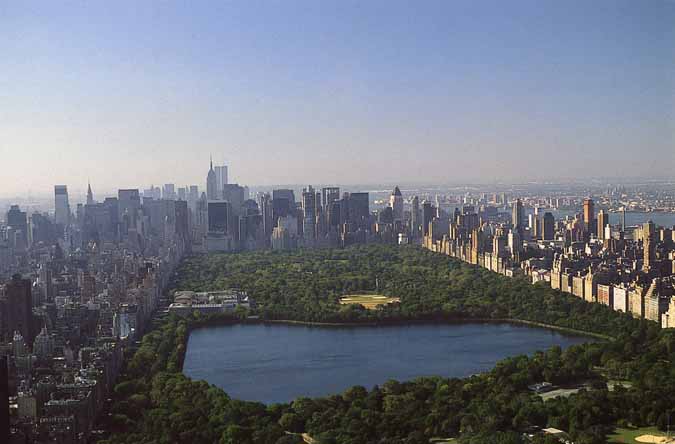







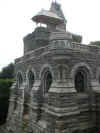



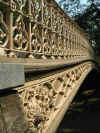







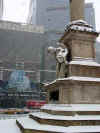
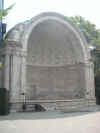

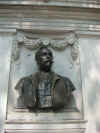

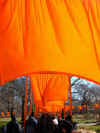
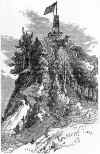 See
also the section on Prospect Park
See
also the section on Prospect Park